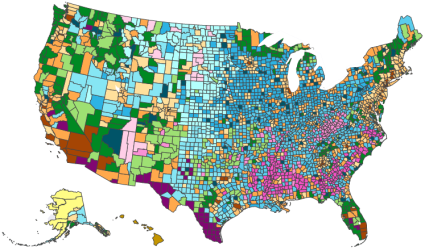This report covers the alarming reality of maternal mortality in the United States, where the maternal mortality ratio (number of maternal deaths per 100,000 births) stands as one of the highest among Organisation for Economic Co-operation and Development (OECD) countries, bucking the global trend of decline. Starting with a mortality rate of 7.2 deaths per 100,000 live births in 1987, the ratio has soared to 32.9 in 2021. In stark contrast, high-income peer countries like Canada had a ratio of 8.6 in 2018, and New Zealand boasted a mere 1.7.
Maternal mortality has multiple potential contributing factors, and a recent review of pregnancy-related deaths in 36 states found that 84 percent were preventable. When there is a disparity in maternal mortality, a corresponding disparity likely exists in one (or several) of maternal mortality’s contributing factors, representing potential targets for policies aimed at reducing these deaths. This report focuses on rates of maternal death in states with large vulnerable populations, focusing on the South and examining disparities by race and age.
Read the full report, linked above, to learn more.

Katherine Sacks
Related Content
-

Milken Institute Announces Five Recommendations to Improve Health Equity for African American and Latino Communities
New report from Alliance to Improve Dementia Care highlights health- and long-term care systems, communities, and workplaces. Washington, D.C. – March 31, 2021 – The Milken Institute today released recommendations to reduce disparities in...Read Article -

Racial Equity and Mental Health in the Workplace: Actions to Drive Systems Change
Nationwide protests in the summer of 2020 sparked many of the largest US corporations to pledge more than $200 billion to advance racial equity and confront the nation’s history of systemic racism. Nonprofits, government agencies, and...Read Report

 11
11
-

Bridging the Racial Wealth Gap: Milken Institute Outlines 14 Strategies to Partner with Mission-Focused Banks
Washington, DC – June 18, 2021 – The Milken Institute today released a set of strategies outlining how corporations, large financial institutions, philanthropic organizations, and governments can leverage mission-focused lenders to better...Read ArticleNew report calls for leveraging Minority Depository Institutions and Community Development Financial Institutions to better meet the needs of underserved communities.
-

The Milken Institute Launches Initiative to Increase Diverse Talent in the Asset Management Industry
DEI in Asset Management Program Aims to Improve Recruitment, Retention and Advancement; Carlyle joins initiative as Strategic Partner and first Underwriter Washington, DC – October 14, 2021 – As part of its ongoing work to elevate diversity...Read ArticleImage
Chad Clinton
Director, Media RelationsChad Clinton is the director of media relations for the Milken Institute. Hired to this role in August 2021, Clinton develops and executes strategies to amplify the Institute’s core messages by generating coverage of its pillar workstreams, experts, and events. -

Milken Institute Announces DEI in Asset Management Executive Council
Inaugural Council Initiated as Part of the Center for Financial Markets’ DEI in Asset Management Initiative Today, the Milken Institute’s Center for Financial Markets (CFM) announced the launch of the DEI in Asset Management Executive...Read ArticleImage
Chad Clinton
Director, Media RelationsChad Clinton is the director of media relations for the Milken Institute. Hired to this role in August 2021, Clinton develops and executes strategies to amplify the Institute’s core messages by generating coverage of its pillar workstreams, experts, and events. -

The Milken Institute’s Community Explorer Tool Offers New, In-Depth County-Level Demographic, Socio-Economic Data to Help Inform Policy Development
WASHINGTON, DC (October 18, 2022) — The Milken Institute announced the release of its Community Explorer, an interactive tool that drills down into various demographic and socio-economic data to help inform policy discussions around housing...Read ArticleImage
Chad Clinton
Director, Media RelationsChad Clinton is the director of media relations for the Milken Institute. Hired to this role in August 2021, Clinton develops and executes strategies to amplify the Institute’s core messages by generating coverage of its pillar workstreams, experts, and events. -

The Milken Institute launches HBCU Fellows Program
WASHINGTON, DC (February 17, 2023) — Today, the Milken Institute launched its Historically Black Colleges and Universities (HBCU) Strategic Initiative and Fellowship Program, which provides participating students with a rigorous eight-week...Read ArticleImage
Chad Clinton
Director, Media RelationsChad Clinton is the director of media relations for the Milken Institute. Hired to this role in August 2021, Clinton develops and executes strategies to amplify the Institute’s core messages by generating coverage of its pillar workstreams, experts, and events. -

ESG Ratings: The Road Ahead
Environmental, social, and governance (ESG) issues have become increasingly important in recent years for investors, spurring companies to be more socially responsible and open about their ESG efforts. This trend is particularly true for...Read Report11 11 Claude Lopez, Oscar Contreras, and Joseph Bendix
Claude Lopez, Oscar Contreras, and Joseph Bendix -
The Community Explorer: Informing Policy with County-Level Data
The Community Explorer investigates US health disparities by first understanding populations’ specificities then looking at their health profile. It identifies the different populations or communities based on their behavioral, demographic...Read Report11 11Claude Lopez and Brittney Butler -

14 Strategies for Partnering with Mission-Focused Banks
Throughout American history, substantial inequality has existed, particularly in minority communities for whom median household wealth continues to lag significantly compared to nonminorities. Compounded by longstanding wealth disparities...Read Report11 11 11Ragini Chawla, Aron Betru, and Xavier Escoto -

Achieving Health Equity: A Multi-Stakeholder Action Plan to Address Diversity across the Clinical Trials Enterprise and the Biomedical Research Ecosystem
Clinical trials have been used for decades as the primary way by which researchers determine if a new treatment is safe and effective for human use. Within the biomedical research ecosystem, participants in clinical trials often do not...Read Report -

The Community Explorer: Using County-Level Data on US Diversity Effectively to Inform Policy
Diversity awareness is becoming an essential element of many policy efforts, from access to health care and financial inclusion to initiatives addressing systemic racism and inequities. Yet most of these discussions and initiatives overlook...Read Report11 11 Claude Lopez, Hyeongyul Roh, and Maggie Switek, PhD
Claude Lopez, Hyeongyul Roh, and Maggie Switek, PhD


